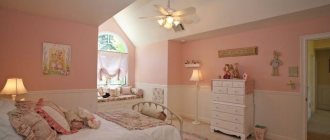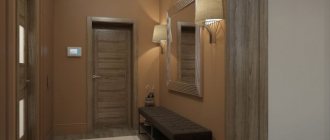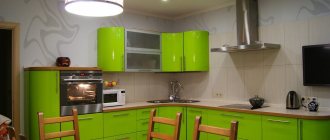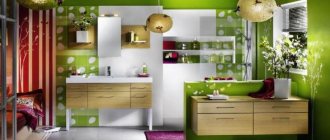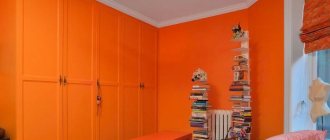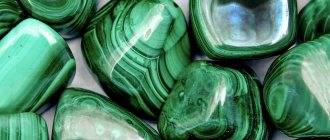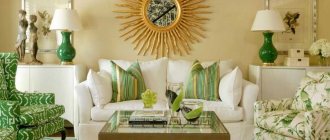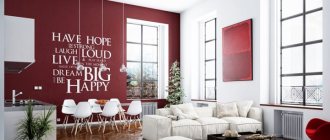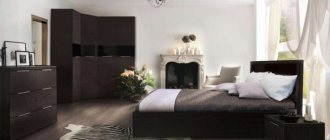- October 26, 2019
- Repair Tips
- Marina Duritsina
Terracotta, which many people associate primarily with the type of ceramics of the same name, has softness, visual purity and some kind of natural elegance. But ask a person who is not experienced in color to answer what color it is - terracotta? In 90% of cases the idea of this tone will be incorrect. And it’s a shame, because this is one of the favorite colors used in design. When used correctly in design code, it can make the interior of a living space more natural and harmonious.
What is color
Terracotta (Italian terra - fired, cotta - clay) is the color of fired ceramic material made from colored clay. Refers to tertiary colors - that is, formed as a result of a combination of primary and secondary or two secondary colors. What color is called terracotta, what accents does it consist of? In particular, terracotta color is formed after mixing red and brown tones. Of course, terracotta color is not at the forefront of the palette, but it has a unique coloring that sets it apart from other tertiary colors.
Terracotta color - what shade is it? Classic terracotta is usually associated with the color of the earth. This is a soft, warm brick shade that instills a sense of calm, instills a sense of stability and security, calms the nerves and immerses a person in a favorable meditative atmosphere. Feng Shui practice involves having calming terracotta elements right at the entrance. However, moderation must be observed - walls completely painted in terracotta color cause the exact opposite effect, creating a feeling of discomfort in a person.
The influence of terracotta color
The brown shade of red is natural, incorporating the full depth of several colors:
- passion red;
- confidence and calmness of brown;
- the life force of orange.
Terracotta is a tertiary color that embodies the colors of ceramics, the brightness of autumn and the austere beauty of rock. This shade is so versatile that it can be used in any room: hall, living room, kitchen, bedroom or nursery.
In order for curtains in a brown shade of red to look advantageous and not hurt the eyes, you need to figure out the colors that go best with it. Companion shades do not include too bright and artificial tones. The terracotta color may get lost against their background.
For your information! This color has a peculiarity - it highlights the sophistication of the design of the room, but at the same time does not draw attention to itself.
This demanding shade is best combined with pastels, as well as confectionery and fruit. The design can be complemented by elements of yellow, reddish and red tones.
How to get the right color
So you've taken up interior design and want to incorporate terracotta into your home's color palette? In this case, you will definitely need knowledge on how to get this color.
How to get terracotta color, what shade is it? If we consider it as a brown shade of red, as is customary in coloristics, then it is quite obvious that these two colors should be used to form the shade - red and brown. The main questions arise already at the stage of choosing paint: in what proportions should colors be mixed? What kind of paint should there be more? The answer is simple - it's up to you to decide. The distribution of proportions when mixing paints affects the final result, but it will still be a terracotta color. There will be more red - the color will be brighter and more aggressive. There will be more brown - the shade will be softer, and sometimes even slightly gloomy.
How to get a light terracotta color, what shade of color is it? To make the tones even richer, you can add a little orange admixture. For lighter, more optimistic, yet soft tones, you can add yellow. You should always experiment with shades, because this is how a new range appears, but try not to overdo it, so as not to lose the terracotta. When mixing different shades in small proportions, make sure that the classic shade (a mixture of red and brown) is not lost.
Choosing terracotta-colored curtains for the bedroom
Bright terracotta can be used in the interior in combination with red and an auxiliary light tone, as a rule, it is white, peach or cherry blossom tone. Not only curtains and curtains should be combined - first of all, they should match the wallpaper.
So, if you decide to decorate your bedroom windows in this warm shade, then you can try to combine it in the interior with red and white options.
If the wallpaper in the bedroom has a shade of red, then you can safely choose textiles in an orange tone, but here the color of the walls plays a big role. If it is a dark and rich color, then the curtains should be 2-3 shades lighter than them. White or any other very light color will help to dilute and add accents. In this combination, the main role is played by contrasts, which are achieved through the play of tones.
You may also be interested in: Design of milky curtains with photo examples
Some people will say that this is an exclusively feminine color combination, but this can be argued, since wallpaper can have quite a different shade of red: it can be purple, burgundy, turquoise and gold or mahogany.
In the interior of a bedroom or even an office, such a palette will be appropriate and comfortable; in this range you can decorate the office of a writer, journalist or person of a creative profession. Orange has always been associated with warmth and comfort, with lightness and joy; these are the feelings that will inspire craftsmen to work.
Acceptable combination of shades:
- orange + burgundy + light peach;
- terracotta + purple + gold;
- carrot + peach.
Each combination is unique and should be considered as a whole, because the slightest semitone can play a very important role.
What colors does terracotta go with?
In the design environment, this shade is considered universal. It pairs well with most primary natural colors while still standing out from them. However, you need to be wary of adding overly bright, acidic shades to the interior that contrast with soft terracotta. But adding cool tones from a pastel palette will only improve the perception of the room.
What color goes with terracotta brick and what combination will be the most successful? Here are a number of recommendations for combining colors that we recommend you listen to:
- Shades of brown go well with shades of white. This tandem is a true classic of colorism and is used to visually expand the space.
- To create a harmonious and cozy atmosphere, you can use a combination of terracotta and beige, milky, cream, caramel shades.
- The harmony of terracotta and dark green creates a special, “natural” impression in everyday life.
- If you focus on black, it will create an interesting contrast that will only benefit the interior.
- Terracotta and orange can be a good pair if you add a little yellow, olive, beige and other paints that will slightly dilute the monochromatic palette.
The easiest way is to choose a terracotta color from a photo. It’s already clear what color it is; it’s interesting that its palette can be combined with almost any shade, the main thing is to design it correctly. For example, if you decorate a terracotta finish with small elements of purple, emerald, or blue, this will well demonstrate the individuality of the room.
Range with an orange-yellow undertone - what color is it? Terracotta? The color in the photo above is one of the variations of this shade, and it is not very successful. Such a tone can damage the entire interior and be unpleasant to the eyes. Also, excessive contrast of cold tones like light blue or turquoise with hot and bright terracotta does not always create a successful tandem. You can use a soft grey-bluish, reminiscent of a light morning mist, and with it, you can further bring out the welcoming terracotta color against it.
Red terracotta - what color is it? This is the predominance of burgundy and copper shades. Milky, creamy, ivory goes well with it. However, you can use a soft grey-bluish, reminiscent of a light morning mist, and with it you can even better bring out the welcoming terracotta color against it.
How to create a stylish look with terracotta color
Many people believe that terracotta color is too rich to create monochromatic looks. The stars prove otherwise:
- Selena Gomez donned a brick suit and paired it with matching ankle boots.
- Kim Kardashian indulged in a sexy latex suit in a rich shade.
The goal of star images is to attract attention. When putting together a set for every day, it is worth choosing more harmonious combinations. No matter how the terracotta goes, try to dilute it with a different color. It will instantly refresh the image and make it more pleasant.
Let's find out what to combine the terracotta shade with and how to create an interesting look for every day.
Combinations with other colors in clothes
For rich colors like terracotta, the best pair is white. So create a gentle, but not boring image. Try these ideas:
Stylistic decisions
As already mentioned, brick red terracotta color is a design classic and fits perfectly into traditional formats such as safari, oriental or country. Often used to transform the interior in ethnic style. The color fits perfectly into the vintage style, as well as into various variations on the theme of ancient Greece and other historical periods. Designers often use it in avant-garde and minimalist works.
Universal terracotta - what color is it? The main feature of this shade is that you can apply it to any artistic idea for working with the interior of a room. Terracotta has an excellent rapport with stone, wood, as well as textiles and ceramics. To give the color a feeling of luxury and solidity, try to use matte surfaces, since glossy ones can indicate your bad taste. You can pleasantly surprise visitors by decorating terracotta walls with textiles made from natural materials. Curtains or upholstery can be made of patterned fabric and have a beautiful design.
If you are working on a large space with windows that receive direct sunlight, then you may not be afraid to use terracotta as the main color. However, in the case of small spaces, too much terracotta is more likely to be harmful, so it is recommended to use it as a background color or add some light colors. For example, if you decorate a small room with wallpaper in light shades, but with a prominent red-brick pattern, it will seem visually larger.
Frequently encountered stylistic combinations with terracotta color in the interior:
- The use of various shades of this color scheme is common in classical and antique styles.
- It’s a rare designer who can refuse red-brick shades in a classic interior.
- The shade looks good in ancient Egyptian or Indian style.
- When creating an ethnic atmosphere, less bright shades can be used; when decorating in a boho or avant-garde style, more saturated ones can be used.
The advantage of using terracotta as the main color in the interior is its ability to perfectly convey the aesthetic beauty of the relief and the texture of the finishing material. Therefore, when covering the walls of a room, use plain wallpaper covered with a beautiful relief pattern. However, the material should not be littered with various decorative unnatural elements such as sparkles, vanilla gloss or golden plating. The trick of finishing in a terracotta shade is its “naturalness”.
In addition, be wise when choosing fabric for upholstery upholstery - terracotta upholstery, made in a classic style, decorated with ethnic patterns and having a fluffy, fleecy texture, is the best choice for a classic room design. Nevertheless, experts categorically do not recommend the use of terracotta when sewing curtains, in particular on windows facing the sunny side. Direct sunlight entering the room through terracotta curtains paints the room in alarming red tones, which can cause a deterioration in well-being and even psychological problems in a person.
Hallway
The hallway is the “face” of the entire house. This is the first room that a guest encounters, which means it should leave a good impression. But at the same time, the interior of the hallway should not be strikingly different from the interior of the rest of the house. Therefore, it is recommended to use furniture in brown or another dark shade against the background of terracotta-covered walls and floors.
A good option for a terracotta color in the interior of a hallway is to add small portions in the form of a wardrobe, a wardrobe or sliding doors in a red-brick shade. The upholstery of the walls can be done with soft cream wallpaper, and the furniture can be white (the use of brown or black furniture is also encouraged).
Brick colors in the interior
The same natural materials are naturally combined with a terracotta interior: wood, stone, ceramics.
Gloss and neon shades are used in decor carefully, to a minimum. For large areas and large objects, it is better to choose matte surfaces as the main ones, and leave the shine to the details
The combination of terracotta colors in the interior is varied, each combination brings an individual flavor to the design:
- Muted shades can be used alone on large surfaces or combined in equal proportions with white, beige or ice cream color.
- Terracotta plus juicy berry tones for the kitchen will appeal to lovers of the exotic.
- The basic, balanced red-brown color scheme is enlivened by combination with bright colors, warm or cool.
- Ocher-yellow and orange colors in combination with blue or greenish shades will add lightness to the interior.
- Walls in the shade of delicate light terracotta look great with moderately decorated friezes the color of freshly fallen snow.
- Pale pink or yellow furniture and textiles look great against the background of terracotta wallpaper.
- Serious people will appreciate the addition of chocolate color to the base terracotta.
A contrasting solution is allowed. The aroma of the East will emanate from the combination of this color with the no less mysterious black. Compositions with white are recognized as classics. This is an attribute of vintage or avant-garde.
Terracotta-colored curtains can be plain or patterned, bright or pastel, but always made from a natural material such as linen.
Living room
Planning a living room design is traditionally considered one of the most difficult aspects of design work. The living room is the largest and most important room. If the hallway creates the first impression on the guest, then by the interior of the living room he already judges the entire furnishings of the house.
To organically and appropriately distribute terracotta color in the interior of the living room, first start decorating the walls, textiles and other accessories. It is recommended to decorate the walls in lighter colors, while the floors, furniture and textiles should be slightly darker. This is due to the fact that flashy accessories in the living room can cause a feeling of bad taste. If the visual environment in the room is calm, then this indicates self-sufficiency and harmony. For example, if you upholster an upholstered chair with bright crimson-brick textiles, then against the background of delicate light shades of the walls it will look classically luxurious. But if the wallpaper is in the same color scheme, then the room will only cause ripples in the eyes.
The combination of wood furniture with brick trim deserves special mention. This is a true design classic. Dark wood and white painted walls are especially combined with this shade. The article contains photos with combinations of terracotta color in the interior with wooden furniture, stairs, and decorative elements. You can always choose a good option.
The best accessories to decorate your living room:
- clay and wooden floor vases;
- designer carpets made of natural materials, animal skins;
- bright paintings in orange, red and terracotta colors;
- curtains and textiles in natural shades.
It is recommended to use only natural materials: linen, cotton, wood, etc. Beautiful linen curtains and textiles, upholstered furniture upholstered in natural materials, solid furniture made of quality wood - all this can be called luxury, but at the same time a sign of good taste, especially for a room like a living room. Similar principles are used when decorating a kitchen.
An important note: to add extra flair, try subtly accenting the look with green accessories. However, the color should not be bright and poisonous; you need a soft, pastel shade of green that would harmoniously combine with the terracotta background and not overshadow it.
The terracotta color in the living room can be made brighter and more saturated, but in this case the scope of its application should be limited. If you plan to cover most of the room in this color, then tone it down slightly. Walls made in calm, slightly dark terracotta can be combined with a white, cream or beige interior. A good solution is to use the contrast between terracotta walls and furniture in blue or black shades. Finally, to make the room brighter and more cheerful, you can add “autumn” tones - a dark yellow or orange palette, with the addition of blue and greenish tint accessories.
Terracotta house
Calm, deep, brick color is appropriate in any room of the house. When deciding where and with what to use it, you need to take into account the dimensions, the degree of illumination of the room, and the color of the existing furnishings.
Hallway
The room, as a rule, is small and insufficiently lit, so wallpaper of dark colors is excluded, only light ones are needed. Against their background, darker wardrobes, laminate flooring, African masks, and mirror edging will look great. They won’t take up space visually, but they will provide a stylish design.
Living room
A real terracotta color in the interior of the living room, if it is large and bright, may well be dominant. The walls are acceptable, saturated, not too light, but not completely dark. Against their background, wooden furniture can be of any color. The best options are black, beige or white wood. Its texture can go well with terracotta finishes.
For small rooms, color is embodied in light wallpaper or other wall decoration. A brick-terracotta or darker sofa will be a contrasting addition.
It should be borne in mind that the bright rich colors of the furniture against the light background of the walls seem even more saturated. In order not to overdo it, the floors are made dark, and furniture, textiles, and accessories are selected lighter. It is better to choose upholstered furniture with textile upholstery. If it is leather or leatherette, a matte surface is preferable. Turquoise or sky-blue islands will add romance.
The living room will look complete with ceramics, natural carpets, and skins. The walls will be decorated with paintings in bright yellow-red and terracotta colors, and curtains made of rough linen.
Kitchen, dining room
These rooms are usually small, so only light-colored walls are allowed. Towels, oven mitts, other textiles, and utensils in ocher, ripe pumpkin, carrot, or other bright colors will add style to the kitchen.
If you want the dining room to look romantic, and a candlelight dinner does not seem out of place, you can decorate it in a pastel range of orange shades. The walls are the lightest, the tablecloth, chair upholstery and curtains are brighter. The darkest of the entire interior will be the floor in the form of fired clay tiles, and the brightest accent will be the dishes.
Bedroom
As a room for relaxation and sound sleep, it is traditionally bright. A calm, space-harmonizing terracotta color in the interior is ideal for a bedroom, even as the main color, so the walls are made in tones of a terracotta palette such as creme brulee or beige. Furnishings in dark, rich colors will brighten the room, but it is appropriate to use them in doses. They may have:
- upholstery of furniture, pillows;
- curtains, bedspreads;
- small accessories such as a clay vase, other ceramics or photo frames;
- wooden bed headboards;
- sconce;
- dressing table.
Terracotta combines beautifully and mysteriously with gray, brown, and blue. These could be glass segments of the facade of a wardrobe, the same curtains, a bedspread.
If the bedroom furniture is white, terracotta walls and brick style are also a good solution. The atmosphere will become more relaxed and stylish, and the brick color scheme will become visually less solid.
Children's
Joyful sunny shades are definitely chosen. An interior in terracotta colors in a nursery will make the child calmer, even more reasonable, and assiduous. It will be easier for schoolchildren to cope with homework in such an environment.
In a girl’s room, it is better to decorate the walls with golden-yellow or soft green wallpaper. The boy will prefer the brick shade. In both cases, the furniture is preferably light blue or light blue.
Bedroom
Don’t think that the bedroom is less important for the perception of a house/apartment than the living room. This room is primarily a place where a person can relax after a hard day, so the environment in it should be calming. This means that when decorating a bedroom, it is recommended to use softer and pastel shades. For example, a mixture of pink, brown and orange gives an airy shade that is ideal for a bedroom interior.
What colors does terracotta go with in a calm bedroom interior? Let's look at several design options and their features.
Option 1 - “Light terracotta with a pink tint”
The use of light shades in the bedroom is justified by the low natural light in the room. Natural clay in such a space looks just like a dark spot, but in a light pinkish tone it is a completely different matter.
Option 2 - “Light terracotta with an orange tint”
Terracotta color, in principle, does not have cold shades. It's always a warm and eye-catching color, especially when you add a little orange. At the same time, it does not go well with pure white, so it is better to replace snow-white bed linen with items of a more saturated shade.
Option 3 - “Terracotta and textured coatings”
Terracotta color is not recommended for use on a smooth glossy surface. Instead, it works well on bumps, rough spots, and soft and fluffy finishes. Wallpaper should not contain sparkles or multi-colored sprinkles; silk pillows should also not be used. When painting walls, you should follow the classic technique with streaks.
Option 4 - “Terracotta + vanilla”
The terracotta color in the bedroom interior in combination with brown and vanilla fits perfectly into the decor of the room. Unlike red, orange and other richly bright colors, terracotta retains the elegance of design solutions and is practically not distracting, while the surrounding space, made in vanilla and brown shades, creates the ideal bedroom atmosphere.
General information
The influence and perception of color
Terracotta is a natural shade and is also considered a rich, warm tone. Psychologically, it is close to all people, although most often it is chosen by strong and self-confident people who value family comfort. Sensual terracotta depth is achieved by combining such tones as cheerful orange, passionate red, and even measured and calm brown. Interiors made in this palette give a feeling of harmony, security, and are also distinguished by their original beauty. If a similar range of colors prevails when decorating walls or furnishings, you can easily relax in the room, take a break from the hustle and bustle of the day, and also feel happy.
Getting terracotta and combining with other shades
Typically this color is obtained by combining yellow, brown and orange. To obtain a more saturated red tone, brown can be replaced with purple. To lighten the tone, white should be added to the resulting paint. Rusty red is obtained by combining orange and brown colors, and to darken terracotta, add a drop of black to the paint. Do you want to make terracotta even calmer, but not darker? In this case, you should change the color to gray, and the rest of the “recipe” remains the same.
Designers consider this color a universal tone that can be easily combined with most types of natural colors and neutral colors. You should be careful when combining terracotta and bright, acidic and unnatural in one interior - the decor can become pretentious. But experiments in combining colors with pastel shades are often successful - terracotta looks great next to any cool or warm light tones.
Tips for combining shades with terracotta color:
All brown shades will go perfectly with white, and such a pair can be considered classic, everything looks fresh, and will also visually expand the space.- No less pleasant will be a tandem of beige, cream, milky, caramel tones and terracotta - the atmosphere is cozy.
- Terracotta and greenery are a harmonious pair, in which the colors give a feeling of closeness to nature, and this is very beneficial for vision.
- Black as an accent against a terracotta background is used to attract attention, and at the same time it is advisable to dilute such a rich palette with white.
- Terracotta and orange will belong to the same range, and then it is recommended to “dilute” them in the interior with yellow, olive, mustard, white, green and beige.
If you wish, you can combine terracotta and other shades. For example, adding additional purple, emerald, turquoise, and blue details to the terracotta-type decoration helps to decorate a room as bright, unusual and memorable.
What styles is the color suitable for?
An interior in terracotta tones or a brick shade is a traditional tone that will include safari, ethno, country, and oriental in formats. This color would look good in a Mediterranean or Tuscan direction - warm, sunny shades that are reminiscent of summer, the coast and the countryside will be popular here. Southwestern style is a great way to use terra cotta.
Brown, yellow, red tones are used in combination with green and black. Be sure to add natural wood, Indian patterns, and original ethnic decorations on the surface of the walls. The use of relevant photographs, hunting trophies, paintings and decorative weapons is encouraged. Terracotta fits perfectly into vintage style, as well as into all antique styles. No less suitable for avant-garde, loft and minimalism. Even with classic interior design options, it can find its place, bringing notes of comfort and warmth to the house.
Kitchen
The most interesting looks are splashes of terracotta color in the kitchen interior. This predominantly small room takes on a unique atmosphere of coziness and warmth. The color of burnt brick is associated with a fireplace, inside of which a burning hearth crackles. It is not without reason that psychologists note that terracotta kitchens stimulate appetite and make you want to sit longer. This is precisely why terracotta is often used in the restaurant industry.
Of course, we are not talking about decorating the kitchen exclusively in this color. It is enough to paint the walls, the surface of tables or even the sink. This color can focus attention on a particular element, for example, on sofa cushions or a tablecloth. A good option is decorating furniture facades, kitchen appliances, etc. You can also combine terracotta with other natural colors - light brown, orange, red and other light shades. You should not combine color with unnatural, neon, toxic tones.
You should also understand that decorating a kitchen in this color suits large, spacious kitchens, but not small ones. In small kitchens this style will seem inappropriate and overly dark, but in a large room it will create an atmosphere of luxury and classics.
Bathroom
There is no point in having a debate about whether terracotta color is appropriate in the bathroom. In the end, the decision must be made by you, and if you are tired of the classic white/gray palette, you can choose shades of the brick we already know.
Successful combinations of terracotta colors in the bathroom interior:
Option 1 - “Terracotta + copper”
Using mostly natural colors is always advisable, but you shouldn't limit yourself to anything. If the bathroom decor allows, then try adding a little copper color to the surface of the bathtub or shelf. The floor, accordingly, is decorated with terracotta tiles. You can add many more different accessories, preferably also in copper color.
Option 2 - “Terracotta + wenge + beige”
Decorate your bathroom in a more classic style by painting the walls and ceiling terracotta and adding a wenge-colored chest of drawers. A room in this design is already associated with luxury and antiquity, but that’s not all. As a final stroke, lay out the tiles in beige color. It will not set off the natural brown that dominates the room, but will make the visual perception of the room a little easier. Of course, such a bathroom setting should only exist in conjunction with other rooms decorated in a similar way.
Children's
The children's room is decorated in light, sunny colors, and the terracotta interior adds an atmosphere of order and tranquility. Psychologists say that burgundy, crimson, and dark orange shades in the room make the child more diligent and improve concentration.
If a girl lives in the room, it is recommended to decorate the walls with gold or soft green. Wallpaper in a rich terracotta shade is just right for a boy. In both cases, furniture must be selected in lighter colors: bluish or light blue. Or, on the contrary, as in the photo, terracotta color in the interior of a children's room is not the main one. It is added with careful touches to the cream and blue. Thanks to this design move, the style of the room turned from strict to playful and modern.
You can arrange the room in the same style as the living room - this is a more “adult” option, with a predominance of strict lines, large arches, contrast between the floor, wall and furniture. The advantage of this method is that the room will not need to be redone again when the child grows up. “Childishness” can be left on multi-colored curtains or canopies above the bed. In the future, you can add some furniture in light shades, which also will not get lost against the white background.
A good backup option is to add terracotta elements in small portions, as if emphasizing the already existing color scheme of the room. It is well known that a green interior is best served with a wood-earth support - it is the latter that is provided by splashes of terracotta. Try adding furniture in brick red tones in particular. Saturated with warmth and freshness, terracotta will look great against the backdrop of a room breathing freshness and greenery, thus creating an amazing atmosphere of summer and warmth.
What shades does it go with?
Non-standard brown is a fairly universal tone of the palette. It harmonizes with various tones. The following combinations are considered the most successful:
- Terracotta plus pink. An interesting tandem that builds on contrast. For the ideal composition, the following tones are selected: ash rose, fuchsia, royal pink, lavender. Such combinations create harmony in the interior and clothing.
- Terracotta plus red. These are two related shades that create a unique composition. Either rich red or burgundy are used. Traditionally, the palette consists of bright red, shades of port, ruby, and wine tones.
- Terracotta color and green. The combination is complete and balanced. Both warm shades of green and cold ones can be used. Pale green, olive, wormwood and grass colors are in perfect harmony with it.
- Terracotta plus blue. This combination is based on thermal contrast, which looks very promising. From the outside, such a combination seems juicy and pronounced. Soft blue, sky, denim, azure are used.
- Terracotta plus purple. The tones will harmonize perfectly only if there is enough red in the purple tone. The richer the tandem, the more visible the unification of the palette will be.
- Terracotta and neutral. The contrast will be noticeable here, but the rich shade will not be noticeable. For this type of combination, beige, cream, light ash, milky, and black are used.
Obviously, the shade can harmonize with different tones of the palette. Therefore, when creating a fashionable design direction, you should not be afraid of inconsistency.
Living room in terracotta and green colors Source evrookna-mos.ru
The use of terracotta-beige finishes in interior design Source alldesigngroup.ru
